Plug-In Power: Why Do I Need Both the 1073 and the 1081?
By Will Shanks
Our current 4.5 software for the UAD features the 1081 EQ as the third plug-in in UA's Neve-licensed series of classic console tools. The Neve 1081 channel amplifier was first produced in 1972 by Neve and was used to provide the mic/line amp and EQ sections in Neve consoles such as the 8048. The 1081 module was immediately embraced as an indispensable studio tool, further establishing the Neve legacy and reputation. It remains highly prized throughout the recording community for its sheer tonal-shifting muscle and unique sound.
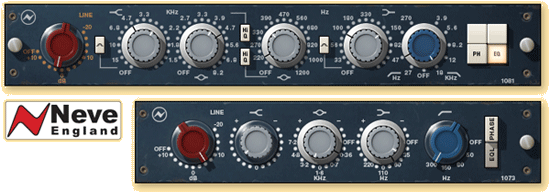 |
|
Neve 1081 EQ (top) and Neve 1073 EQ
|
1073 and 1081 Differences
You may say, "I already own the 1073 EQ. Why do I need both the 1073 and the 1081 plug-ins?" Great question! The short answer is, because they really are different from each other, and each is unique and suitable for specific tasks. Furthermore, they can be highly complementary to one another in a mix.
"...beyond the fantastic feature additions with the 1081, there were circuit changes as well as discernable sonic differences from the 1073"
The most obvious difference between the 1081 and the 1073 is the 1081's larger feature set. The 1081 adds an additional parametric band, giving the user much wider low-midrange and high-midrange frequency accessibility. Each parametric band has ten frequency selections. The 1081 adds Q selection (Low and High) for both parametric bands. With the high and low shelving bands, the 1081 expands the selectable frequency ranges on each band (the 1073's high shelf is a fixed 12 kHz) and offers a different palette of frequency choices. In addition, the 1081's two shelf filters each have the ability to change from shelf to bell curves. To top it off, unlike the 1073, the 1081 includes both high- and low-cut filters, also featuring expanded frequency ranges.
But beyond the fantastic feature additions with the 1081, there were circuit changes as well as discernable sonic differences from the 1073. Although still unmistakably Neve in its sonic fingerprint, the 1081 brought improvements to the design that also changed the tonality of Neve consoles. At the time there were certain "anomalies" in the 1073 that may have been deemed worthy of improvement at the time of Neve's implementation of the 1081. However, time and countless records have proven as with many classic audio tools, sometimes the "warts" add to the very magic the device imparts.
Uniqueness of 1073 Filters
The 1073 cut filters are not exactly "textbook perfect" in their shape. However, these less-than-perfect cut filters have a certain magic that make them extremely musical, especially combined with the boosted bass shelf filter of the 1073. Also, with very little experimentation, it becomes obvious that the fixed 12 kHz filter on the 1073 is affecting frequencies well below the stated 12 kHz. Under examination, the 1073's high-shelf filter also looks unusual when put on a graph. But who could ever complain about the high-frequency magic this amazing filter imparts?
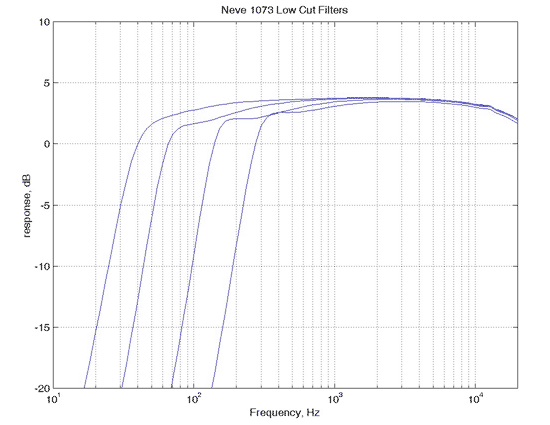 |
|
Neve 1073 Low Cut Filters |
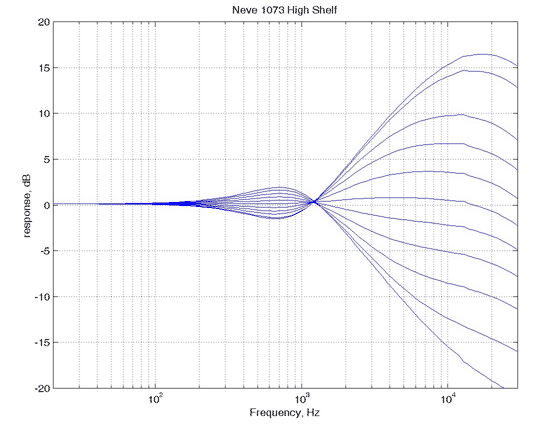 |
|
Neve 1073 High Shelf |
Uniqueness of 1081 Filters
One might say the filters of the 1081 are a bit more "textbook" when put on a graph, but only by a margin, especially compared with a truly generic filter. There is still plenty of magic in the 1081, but of a different flavor. In particular, the filter shapes in the end bands are unusual, particularly when set to "Bell," and impart a coloration unlike any other EQ.
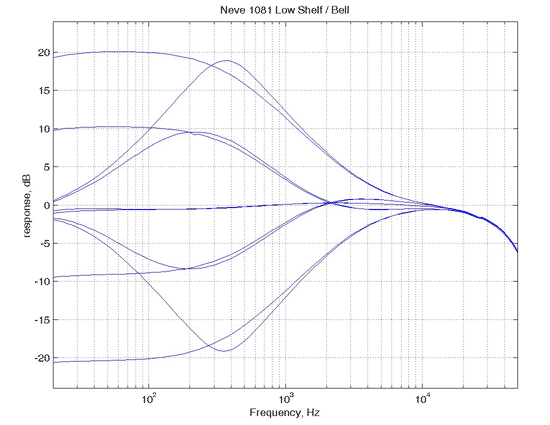 |
|
Neve 1081 Low Shelf / Bell |
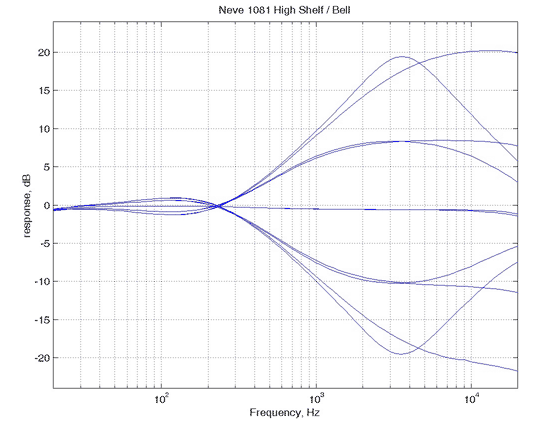 |
|
Neve 1081 High Shelf / Bell |
I mentioned earlier that the 1081 and 1073 are highly complementary. As both units are Neve, they impart a similar tonality. They work amazingly well together on a mix. As an experiment, I would recommend using only the 1073 /1073 SE and 1081/1081 SE on a mix to experience the quantitative effect on mixing only with the Neve filter sound. It can be quite revealing, and can impart a perceptible "Neve console sound" to your mix. To add to the sonic recipe, use only compressors of the same era, such as the 1176 with the Plate 140 for reverb and the Space Echo for delays. With this, you now have the ability to mix an authentic early-'70s "period piece"!
Specific 1073 Uses
Typically I will use the 1073 for general tone shaping and sweetening, especially on things like vocals, overheads, bass and guitars. The high shelf is very complimentary to high frequencies, and works extremely well in adding air and sizzle to things like vocals or overheads. The midrange boost of the 1073 has worked magic on guitars and basses for me, adding just the right bite and articulation even with very minimal boosts. However, when extreme boosts are necessary, the 1073 midband almost always stays musical and does not impart the usual harshness of extreme filter boosts. Also the trick of using the cut filter while boosting the bass shelf filter imparts a magic I have not found with any device other than the 1073.
Watch this example of dialing the upright bass in the mix with the 1073. I use the low cut filter and bass shelf boost simultaneously, which achieves a fantastic, thick but controlled low-end. I then add an extreme midrange boost for lots of attack and string noise, which makes the upright pop right out in the mix, with a nice aggressive growl. I then add just a bit of the high shelf to add some room ambience, which gives the instrument greater dimension.
Specific 1081 Uses
While the 1081 also imparts a unique tonality different from the 1073 when performing simple filtering tasks as described above (and has greater control for such tasks), the 1081 is the logical device when more control is needed. The 1081 is perfectly designed for more surgical operations, such as tailoring drums sounds like close-miked kick, snare and tom-toms.
You will find that the 1081 is perfect for dialing in just the right amount of sub-frequency energy and click on a kick drum. I dial in the subharmonics with the low band set to bell filter. With the lower midrange parametric band I am able cut out the midrange/mudrange of the drum, unmasking some of the detail and energy of the electric bass. Last, I boost the click/attack of the drum with the high midrange parametric band, turning the kick into a more modern-sounding instrument.
The 1081 is also commonly used for dialing thick, aggressive sounds on individual tom-toms. The 1081 is perfect for the exaggerated filtering typically called for in the genre that yields an explosive attack with a short decay. Dialing the low-end punch and high-end attack while scooping out the most offensive frequencies in the midrange yields the classic rock tom sound many are familiar with.
The 1081 is also perfect for bus EQing, allowing the user the expanded control needed to tailor the bus with surgical boosts and cuts, but imparting the Neve sound on the overall bus or overall mix.

